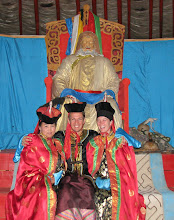Acoma Native Ameican
Acoma
![A Photograph of Acoma Fiesta of San Estevan [A].](http://www.firstpeople.us/american-indian/photographs/ls/acoma-fiesta-of-san-estevan-a.jpg)
The Acoma, "people of the white rock," are one of many pueblo cultures of the southwest. Acoma Pueblo is located in west central New Mexico. The pueblo is multi-unit, multi-family dwelling made of adobe bricks.
The Acoma pueblo village, located at the top of a 350-foot steep mesa that was carved from a huge plateau thousands of years ago by fast-moving river water. It stands imposing in the midst of barren land to the uneducated, but this place has been home to the Acoma people for more than 800 years. Its positioning provided natural defenses against enemies who would try to steal corn they raised, and the arid land actually is home to a host of dozens of plants and small, burrowing animals that provide additional sources of food.
Masters of ultilizing the small amounts of water available to them, crops of corn, beans and squash were managed by planting near springs at the foot of the mesa. Later the Spanish introduced sheep, goats and horses to the Acoma and herding and breeding became prevelent in addition to hunting for rabbit and deer.
Early clothing included buckskin clothing for men at first, but after contact with the Spanish dress evolved into the more European looking black cotten pants and shirts. Women have traditionally worn one-piece dresses that went over one shoulder and tied around the waist.
Every year the Acoma hold festivals such as dances to the rain and corn, in thanks for the blessings of the gods. Puebloan culture sacred ceremonies are held in underground chambers known as kivas, into which the participants enter by ladder. Non-Indian indivduals are not allowed into the sacred spaces.
The Acoma culture exists today despite the fact half the population was eliminated in 1599 by a Spanish explorer who did so to avenge the death of a brother who had been murdered in the area. Almost 30 years later, the Spanish Catholic church arrived to establish a mission. The Acoma did not resist, and although some conversion and missionary work took place, the missionairies worked the Acoma hard to produce crops and arts and crafts which was then sold in Europe and Mexico for large profits, not for the Acoma, but for the Spanish.
While the Spanish were present to "save the souls" of the Acoma, they were not allowed to practice their own religion. As a result, when they were asked by neighboring pueblo peoples to join a revolt against the Spanish in 1680 they did not hesitate. Though the revolt was successful, drought plagued the land the Spanish believed belonged to them. In 1689 the Spanish deeded the Acoma the land on which the pueblo village sat and some nearby grazing lands. However, within 20 years the Spanish were back, and by the 1800s, other European groups arrived, bringing with them smallpox and other killer diseases. Again, the Acoma did not resist and eventually the tribal population was reduced to fewer than a thousand people. The white population encroached on Acoma land illegally for many years until continued Acoma protests forced the United States government intervene and create protection of the land.
Today, many Acoma still reside in the old pueblo village atop the mesa, while others live in more modern communities in valley below the pueblo.


0 Comments:
Post a Comment
Subscribe to Post Comments [Atom]
<< Home